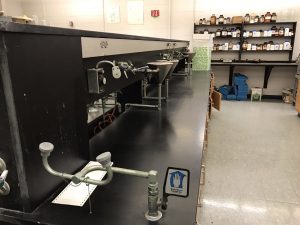Dr. Tang’s dedicated laboratory is located in Room 104 of Weyandt Hall. Six rows of lab benches for research use only are illustrated in the photos below. At IUP, teaching labs and research labs are separate.
One of two fume hoods in the lab (the following left photo) is dedicated for extraction of volatile organic compounds (e.g. disinfection by-products) from water samples. The extracted samples are brought upstairs to Room 238 where a Gas Chromatograph (Model # Agilent 6890 GC-MS, the following right photo) is located for analysis of volatile organics.
To support the research and development of electrochemical water desalination technologies in the lab, Dr. Tang acquired AC/DC variable power supplies (the following left photo) and an oxygen analyzer (the following right photo) for operation of our bench-scale capacitive deionization apparatus.
Our centralized instruments are able to do a series of water quality analysis. The photos below are our Ion Chromatograph (Model # Metrohm 850 Profession IC, the following left photo) and UV-Vis spectrometer (Model # Hitachi U-3900, the following right photo) located in Room 237. Dr. Tang is currently in the process of acquiring a Total Organic Carbon Analyzer, which will further enhance the water analytical capability of the lab.
For trace cation analysis, there is an ICP-OES (Model # Perkin Elmer Optima 2100 DV inductively coupled plasma optical emission spectrometer) located in Geoscience Department and it is available for faculty and student use. In our own Chemistry Department, we also have the following FTIR spectrometers (Model # Hitachi F-2500 (left) and Thermo Nicolet 4700 (right)).
Centralized facilities in our own Chemistry Department also include an Agilent 1100 series HPLC (the following left photo), Powder x-ray diffractometer, Single Crystal X-ray, and many others. Besides, the Milli-Q ultrapure (nanopure) water purification system (the following right photo) is located upstairs in Room 237.











